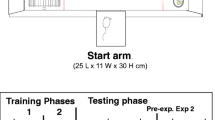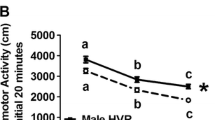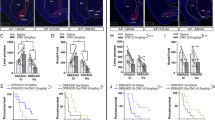Abstract
Behavioral effects of dopaminergic stimulation were evaluated in C57BL/6J mice and compared to the effects occurring in DBA/2J mice, an inbred strain with reduced densities of striatal dopamine receptors. Effects of apomorphine (0.5–64 mg/kg) alone and in combination with cocaine (30 mg/kg) were assessed using a time-sampling technique that classified climbing and leaning in separate categories. Locomotion was also assessed in a separate experiment. Climbing occurred in DBA/2J mice only at doses of apomorphine that were 16 times higher than the smallest effective dose in C57BL/6J mice; nevertheless, relative to baseline values, effects were fairly comparable. By contrast, whereas DBA/2J mice showed dose-dependent leaning under apomorphine, C57BL/6J mice exhibited little leaning even at doses not producing climbing, and only after the highest apomorphine dose was leaning significantly increased. Apomorphine was equipotent in inducing gnawing across strains, although somewhat less efficacious in DBA/2J mice. When given alone, cocaine produced significant climbing, but not leaning or gnawing, in either strain. Whereas cocaine potentiated apomorphine-induced climbing and gnawing in both strains, apomorphine-induced leaning was not consistently changed by cocaine in either strain. These effects were not indirectly due to hyperkinesia, since neither apomorphine alone nor apomorphine and cocaine in combination was stimulant; apomorphine alone reduced locomotor activity and attenuated cocaine-induced hyperkinesia. The present data do not support a unitary, purely quantitative, account of insensitivity to dopaminergic stimulation based upon low densities of striatal dopamine receptors in DBA/2J mice. Rather, this constellation of results is suggestive of qualitative interstrain dissimilarities in dopaminergic responsiveness that could reflect organizational differences in receptor populations.
Similar content being viewed by others
References
Balsana JJ, Bopat TR, Gada VP, Chandorkar AG (1982) Small doses of apomorphine induce catalepsy and antagonize methamphetamine stereotypy in rats. Psychopharmacology 78:192–194
Benuck M, Reith MEA, Lajtha A (1987) Pharmacokinetics of systematically administered cocaine and locomotor stimulation in mice. J Pharmacol Exp Ther 243:144–149
Bhattacharya SK, Sen AP (1991) Effect of cholinergic receptor agonists and antagonists on dopamine-mediated behavioural paradigms. J Neural Transm [Gen Sect] 84:241–246
Boehme RE, Cianarello RD (1981) Dopamine receptor binding in inbred mice: Strain differences in mesolimbic and nigrostriatal dopamine binding sites. Proc Natl Acad Sci USA 78:3255–3259
Boehme RE, Ciaranello RD (1982) Genetic control of dopamine and serotonin receptors in brain regions of inbred mice. Brain Res 266:51–65
Bradbury AJ, Costall B, Naylor RJ, Neumeyer JL (1983) Motor inhibition induced by aporphine derivatives in the mouse. J Pharm Pharmacol 35:494–499
Cabib S, Puglisi-Allegra S (1985) Different effects of apomorphine on climbing behavior and locomotor activity in three strains of mice. Pharmacol Biochem Behav 23:555–557
Cabib S, Puglisi-Allegra S (1988) A classical genetic analysis of two apomorphine-induced behaviors in the mouse. Pharmacol Biochem Behav 30:143–147
Carney JM, Warren R, Cheng MS, Seale TW (1991) Establishment of chronic intravenous drug self-administration in the C57Bl/6J mouse. NeuroReport 2:477–480
Chandler CJ, Wohab W, Starr BS, Starr MS (1990) Motor depression: a new role for D1 receptors? Neuroscience 38:437–445
Costall B, Naylor RJ, Nohria V (1981) Use of intra-cerebral injection technique to elucidate mechanisms of apomorphine induced climbing and its antagonism in the mouse. Psychopharmacology 73:91–99
Dunn RW, Kruse H, Geyer HM, Novick WJ, Fielding S (1980) The effects of GABA agonists and antagonists on apomorphine-induced climbing. Brain Res Bull 5 [Suppl 1]:433–437
Duterte-Boucher D, Costentin J (1989) Appearance of a stereotyped apomorphine-induced climbing in unresponsive DBA2 mice after subchronic manipulations of brain dopamine transmission. Psychopharmacology 98:56–60
Frischknecht HR, Siegfried B, Bosh TK (1982) Opioids and behavior: genetic aspects. Experientia 44:473–481
Fung YK, Novim-Baheram A, Bosh TK, Grassmann DR (1982) An in-vivo method for testing GABA ergic compounds. Pharmacol Biochem Behav 17:651–654
Gessa GL, Porceddu ML, Collu M, Mereu GP, Serra M, Ongini E, Biggio G (1985) Sedation and sleep induced by high doses of apomorphine after blockade of D1 receptors by SCH 23390. Eur J Pharmacol 109:269–274
Hedley LR, Wallach MB (1983) Potentiation of apomorphine-induced gnawing in mice. Prog Neuropsychopharmacol Biol Psychiatry 7:47–56
Helmeste DM (1983) Spontaneous and apomorphine-induced locomotor changes parallel dopamine receptor differences in two rat strains. Pharmacol Biochem Behav 19:153–155
Helmeste DM, Seeman P (1982) Amphetamine-induced hypolocomotion in mice with more brain D2 dopamine receptors. Psychiatry Res 7:351–359
Jackson DM, Dreher SD, Ross SB (1987) D1 and D2 dopamine agonist synergism and the nucleus accumbens. Trends Pharmacol Sci 8:419–420
Kendler KS, Davis KL (1984) Genetic control of apomorphine-induced climbing behavior in two inbred mouse strains. Brain Res 293:343–351
Kirk RE (1982) Experimental design: procedures for the behavioral sciences (2nd edition). Brooks/Cole, Belmont, Calif
Klemm WR (1989) Drug effects on active immobility responses: what they tell us about neurotransmitter systems and motor functions. Prog Neurobiol 32:403–422
Kuribara H, Tadokoro S (1989) Reverse tolerance to ambulation-increasing effect of methamphetamine and morphine in 6 mouse strains. Jpn J Pharmacol 49:197–203
Lapin IP (1975) Effects of apomorphine in mice of different strains. In: Eleftheriou BE (ed) Psychopharmacogenetics. Plenum, New York, pp 19–32
Marçais H, Protais P, Costentin J, Schwartz JC (1978) A gradual score to evaluate climbing behaviour elicited by apomorphine in mice. Psychopharmacology 56:233–234
Marley RJ, Witkin JM, Goldberg SR (1991) Genetic factors influence changes in sensitivity to the convulsant properties of cocaine following chronic treatment. Brain Res 542:1–7
Martin GE, Bendesky RJ (1984) Mouse locomotor activity: an in vivo test for dopamine autoreceptor activation. J Pharmacol Exp Ther 229:706–711
Michaluk J, Antkiewicz-Michaluk L, Rokosz-Pelc A, Sansone M, Oliverio A, Vetulani J (1982) Dopamine receptors in the striatum and limbic system of various strains of mice: relation to differences in responses to apomorphine. Pharmacol Biochem Behav 17:1115–1118
Moore NA, Axton MS (1988) Production of climbing behaviour in mice requires both D1 and D2 receptor activation. Psychopharmacology 94:263–266
Protais P, Bonnet J, Costentin J (1976) Climbing behavior induced by apomorphine: a simple test for the study of dopamine receptors in the striatum. Psychopharmacology 50:1–6
Protais P, Bonnet JJ, Costentin J (1983) Pharmacological characterization of the receptors involved in the apomorphine-induced polyphasic modifications of locomotor activity in mice. Psychopharmacology 81:126–134
Puglisi-Allegra S, Carletti P, Cabib S (1990) LY 171555-induced catalepsy and defensive behavior in four strains of mice suggest the involvement of different D2 dopamine receptor systems. Pharmacol Biochem Behav 36:327–331
Quock RM (1982) Naloxone potentiation of apomorphine-induced stereotypic climbing in mice and interaction with mu-, sigma- and kappa-opiate drugs. Life Sci 31:2907–2911
Randall PK, Randall JS (1986) Mouse strain differences in apomorphine-induced behavior: an empirical and methodological study. Behav Neurosci 100:85–92
Ruth JA, Ullman EA, Collins AC (1988) An analysis of cocaine effects on locomotor activities and heart rate in four inbred mouse strains. Pharmacol Biochem Behav 29:157–162
Sansone M, Ammassari-Teule M, Renzi P, Oliverio A (1981) Different effects of apomorphine on locomotor activity in C57BL/6 and DBA/2 mice. Pharmacol Biochem Behav 14:741–743
Seale TW, Carney JM (1991) Genetic determinants of susceptibility to the rewarding and other behavioral actions of cocaine. J Addict Dis 10:141–162
Seale PW, McLanahan K, Johnson P, Carney JM, Rennert OM (1984) Systematic comparison of apomorphine-induced behavioral changes in two mouse strains with inherited differences in brain dopamine receptors. Pharmacol Biochem Behav 21:237–244
Severson JA, Randall PK, Finch CE (1981) Genotype influences on striatal dopaminergic regulation in mice. Brain Res 210:201–215
Shannon HE, Bemis KG, Peters SC (1991) Potency and efficacy of dopamine agonists in mouse strains differing in dopamine cell and receptor number. Pharmacol Biochem Behav 40:103–107
Schuster L (1992) Pharmacokinetics, metabolism and disposition of cocaine. In Lakoski JM, Galloway MP, White FJ (eds) Cocaine: pharmacology, physiology and clinical strategies. CRC Press, Boca Raton, pp 1–14
Srinskaya JA, Nikulina EM, Popova NK (1992) Role of genotype in brain dopamine metabolism and dopamine-dependent behavior of mice. Pharmacol Biochem Behav 42:261–267
Stähle L, Ungerstedt U (1986) Effects of neuroleptic drugs on inhibition of exploratory behavior induced by a low dose of apomorphine: implication for the identity of dopamine receptors. Pharmacol Biochem Behav 25:473–480
Starr BS, Starr MS (1986) Differential effects of dopamine D1 and D2 agonists and antagonists on velocity of movement, rearing and grooming in the mouse. Neuropharmacology 25:455–463
Suen HK, Ary D (1989) Analyzing quantitative behavioral observation data. Lawrence Erlbaum, Hillsdale, NJ
Tirelli E, Witkin J (1994) Gnawing induced by dopaminergic mobilization: Differential effects of direct and indirect dopamine agonists in mice. J Pharmacol Exp Ther,in press
Van Abeelen JHF (1989) Genetic control of hippocampal cholinergic and dynorphinergic mechanisms regulating novelty-induced exploratory behavior in house mouse. Experientia 45:839–845
Vasse M, Chagraoui A, Protais P (1988) Climbing and stereotyped behaviours in mice require the stimulation of D1 dopamine receptors. Eur J Pharmacol 148:221–229
Vetulani J, Sansone M, Oliverio A (1981) Analysis of the difference in the behavioral effects of apomorphine in C57B1/6 and DBA/2 mice. Pharmacol Biochem Behav 17:967–971
Wenger GR (1989) The role of control activity levels in the reported strain differences to the behavioral effects of drugs in mice. Pharmacol Biochem Behav 32:241–247
Wiener HL, Reith MEA (1990) Correlation between cocaine-induced locomotion and cocaine disposition in the brain among four inbred strains of mice. Pharmacol Biochem Behav 36:699–701
Author information
Authors and Affiliations
Additional information
The facilities in which the mice were maintained are fully accredited by the American Association for the Accreditation of Laboratory Animal Care (AAALAC), and the studies described here were conducted in accordance with the Guide for Care and Use of Laboratory Animals provided by the NIH and adopted by NIDA.
Rights and permissions
About this article
Cite this article
Tirelli, E., Witkin, J.M. Verticalization of behavior elicited by dopaminergic mobilization is qualitatively different between C57BL/6J and DBA/2J mice. Psychopharmacology 116, 191–200 (1994). https://doi.org/10.1007/BF02245062
Received:
Revised:
Issue Date:
DOI: https://doi.org/10.1007/BF02245062




